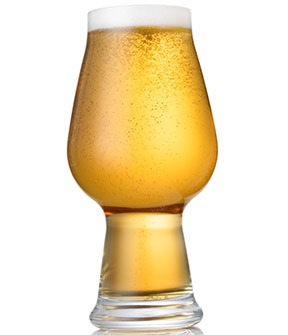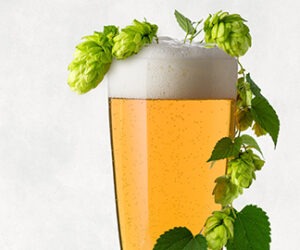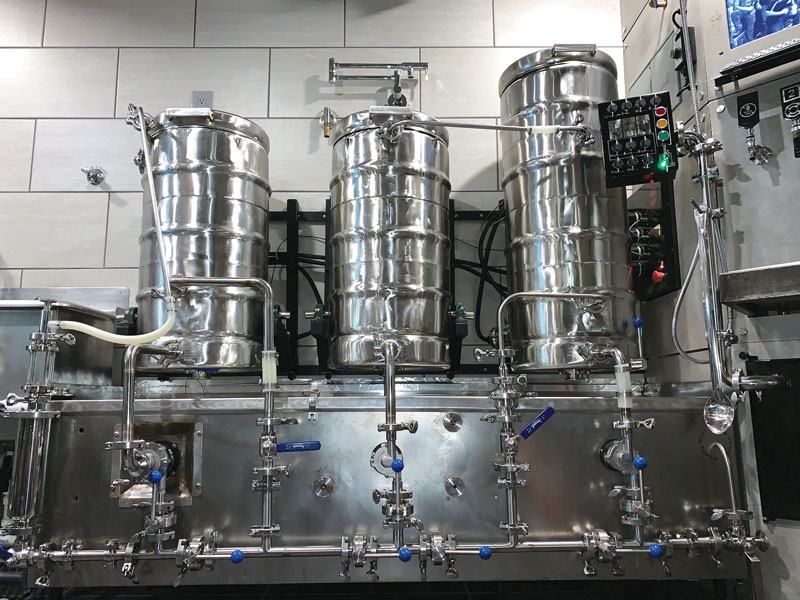Cold IPA

I shouldn’t be so conflicted writing about a style I really enjoy, but I’m a bit uncertain how to characterize cold IPA. My basic dilemma is whether to talk about it as a new, distinct style, or to think about it more as the natural evolution of American IPA. While it’s tempting to present it as a distinct style — especially given its clean, dry finish and crisp hop profile — I suspect it may actually represent what IPAs are becoming. With a flavor profile reminiscent of a West Coast IPA, yet paler, drier, and often smoother, cold IPA typically lands in the mid-6% to nearly 8% ABV range. Whether it’s a reinvention or a refinement, its growing popularity suggests it’s worth paying attention to.
Cold IPA absolutely has an origin story, but how other brewers are making it can be seen as the complicating factor. One mistake I would rather avoid making is describing the style based on how the original example was made since that ignores the range of the style. When I think about the changes to make to the American IPA style to allow it to encompass cold IPA, the changes are actually fairly minimal. But when I drink the beer, it seems like something a bit different.
OK, I’ve teased you enough. Cold IPA is not currently recognized as a Beer Judge Certification Program (BJCP) style. It could be entered in the 21B Specialty IPA category, with an explanation that it is a cold IPA. A short explanation of the recipe changes from an American IPA (21A) could be sufficient, or judges may insert their own judgment about what constitutes a cold IPA (admittedly, a risky choice, depending on the competition and the experience of the judges).
History
I’ve written extensively in these pages about the history of IPA, the original English IPA, and how IPA evolved into more modern American forms such as the popular West Coast IPA (which covers much of the current American IPA style). I’ve also written about the other current American IPA, the hazy IPA. Cold IPA is essentially a tweak of West Coast IPA using some process and ingredient changes inspired by lager brewing.
Cold IPA was a project of Kevin Davey while he was Brewmaster at Wayfinder Beer in Portland, Oregon. They first released the beer in October 2018 as Relapse IPA, but it has since been renamed to Wayfinder Original Cold IPA. It became very popular and trendy in the times when we were emerging from the COVID pandemic, especially in 2022 and 2023. While no longer having the newness buzz it once had, it remains a popular style of beer even if it is not consistently named.
After I judged at the Great American Beer Festival in 2022, I sought out Kevin Davey at Wayfinder for his firsthand take on the style and what he thought of other examples. I found it notable that he had high praise for Firestone Walker’s Hopnosis IPA, even though Matt Brynildson used another path to get to a similar result. Remember this moment, since it is the basis of my problem with characterizing the style, as I discuss later.
Many articles were written introducing the style, offering recipes, and discussing the origin. Perhaps with the recent memory of brut IPA still fresh, the messaging around the beer and the style was noticeably different. However, the comparison with brut IPA is apt because it shared the same goal of cold IPA — to be a drier, more drinkable, clearer counterpart to the hazy IPA juggernaut.
Wayfinder themselves describes cold IPA as “Wester than West Coast,” implying that the essence of a great West Coast IPA is at the heart of the style. It also introduces lager yeast (potentially) but tries to avoid the issues that surrounded the so-called India pale lager, or IPL — most notably how the sulfur from lager yeast and fermentation would often clash with the sulfur in many modern hops. Stan Hieronymus had previously described to me that beers had a kind of sulfur limit or budget that couldn’t be exceeded without having detrimental sensory effects (meaning, that it becomes unpleasant to drink). It’s a concept that I think has merit and I hope to explore more in the future.
The original cold IPA at Wayfinder was distinguished from a West Coast IPA by using rice or corn adjuncts like an American lager or cream ale, using a clean, low-sulfur lager yeast fermented warmer than is typical, fermenting totally dry with a lower final gravity, and using some biotransformation methods with hopping during fermentation. The lower final gravity means that overall bitterness should be reduced (as in brut IPA) to achieve a more drinkable balance.
Sensory Profile
A cold IPA has a similar profile to a West Coast IPA, but is often paler, drier, and smoother. The alcohol strength is similar, from mid-6% to nearly 8%, but the starting and finishing gravities are often lower to gain the additional dryness. The apparent bitterness level is similar, but measured IBUs could be a little lower (45–70) due to the dry finish.
The beer can be quite pale, especially in variations using rice. The color can be as low as 2.5 SRM, but shouldn’t get into the gold colors. Clarity can be excellent, although a light haze is possible in unfiltered versions.
The malt profile is relatively neutral, and caramel flavors should be absent. Bitterness is significant, in the medium-high to high range, but a clean bitterness profile without harshness is most desirable. The hop flavor and aroma should be substantial, and can take many directions. Many versions feature biotransformation effects with additional tropical fruit character, but all classic American IPA hop descriptors could be used. A fresh dry-hopped character is typical.
The body is low to medium-low (possibly a shade lighter than West Coast IPA), and the beer is well-carbonated. The palate seems smooth, and any alcohol should not be too evident. Fermentation character can seem relatively neutral to lightly fruity and should complement the hops, not clash with them. The sulfur content (from any source, including water) should be relatively low to not fight with the hops.
From a sensory standpoint, the beer is slightly different from a West Coast IPA, but not so different that a reworked American IPA style description couldn’t cover it. I worry more about the potential overlap between a hypothetical cold IPA style and the American or West Coast IPA style, and whether judges could reliably distinguish these differences in competitions.
Brewing Ingredients and Methods
This is where the differences between excellent commercial examples comes into play. If we examine Wayfinder’s version, they use corn or rice adjuncts — which have the same starch composition as barley with 75% amylopectin and 25% amylose, but the absence of a husk leads to a lighter resulting beer with less soluble protein. Firestone Walker, on the other hand, uses an all-malt grist with a German-inspired step mash. Which is correct? Both are, since they each lead to a similar sensory result. But this causes problems if attempting to define the beer by its use of adjuncts since there is such a notable counter-example.
Malt is generally a pale North American variety without too much flavor. I think some German Pilsner malt could be used in the grist as well, but I wouldn’t want it to add a dominant flavor. Adding too much additional character malt could give the beer too much color as well. The modern West Coast IPA trend of avoiding crystal malts at all costs is fully in play. Anything dark has no place in this style.
Lager yeast is typically used for fermentation, but with a warmer fermentation to help drive off sulfur. The classic German SafLager W-34/70 strain is frequently mentioned as suitable for this style. Neutral ale yeast or a Kölsch yeast are often mentioned as possible substitutes, especially when used with a cooler than standard ale fermentation regime. Again, multiple paths to get to the same sensory goal — a low-sulfur, clean, well-fermented beer.
Water composition eschews the Burtonization methods and sulfate-rich composition for a more neutral profile. Any calcium additions to aid mash performance should be done with the goal of keeping the finished sulfur levels low, which leads me to choose calcium chloride more frequently.
The hop methods pick up some modern methods from hazy IPAs that are more frequently being applied to American IPAs, including biotransformation through dry hopping during active fermentation. Various late hopping techniques can be used, with nothing ruled out. Hop choices are up to the brewer, as long as they display modern American IPA characteristics, even if they come from New World locations such as New Zealand. Again, the sensory goal is the target more than the method. New hop forms and products may be used if they are increasing hop character while minimizing detrimental effects of overhopping, such as hop burn.
I realize these descriptions are not very explicit in the path, but that is intentional since I am trying to characterize the goal is more important than the many possible methods and ingredients to reach it. Finding an approach that works on your system is the key to success.
I would like to emphasize that the methods I’m describing really do illustrate the ways that modern ingredients and techniques used in other styles (even hazy IPA) are finding their way into this style. This helps support the notion that the American or West Coast IPA may be evolving, as it did in the late 1990s and early 2000s when brewers started moving away from crystal malts and started developing (or rediscovering) additional methods of late hopping.
Homebrew Example
My example uses some of the modern IPA techniques advocated by Kevin Davey and Matt Brynildson, while using some of my tried-and-true favorite IPA methods. It uses a neutral pale American base malt and rice, but without any cereal mashes. I use step mashing for extra attenuation as well. The hopping is all Mosaic®, something I have used to great success in double IPAs, with the nod to Firestone Walker by making some of them CryoTM hops. Lager yeast is fermented warmer than typical, with both fermentation hopping for biotransformation and traditional dry hopping.
There is some wiggle room on this recipe, of course. Any pale, neutral malt combination can be used as the base. Corn can be used instead of rice, but I’m not looking for any corn flavor or impression of sweetness, so I stick to rice, which also helps keep the color light. Step mashing is my preferred choice for dry, well-attenuated beers, but if you can only do a single infusion, keep it low, like at 149 °F (65 °C).
Cold IPA is indeed a blank canvas for hops, so you can use your own choices as well. I’m not going super bitter since it is a dry beer, and I’m emphasizing the late additions for maximum aroma and flavor. Normal hops can be substituted if CryoTM hops are unavailable, but I would still use the two-stage dry hopping approach.
Other yeast can be used, as long as it is a low sulfur producer. A clean, neutral ale yeast can be used. Some use a Kölsch yeast, although I find they can be a bit sulfury. The warmer lager fermentation temperature is more for reducing sulfur than producing esters, and can be conducted slightly warmer if desired (64–68 °F/18–20 °C).
The goal here is for a very light colored, dry, clean, and crisp beer with a strong hop character and a smooth palate. The hop aroma should be substantial, but the overall profile should seem relatively neutral. For those who like lagers, especially hoppy lagers, this beer should be appealing. Just don’t tell me what it’s called or ask me how to categorize it; I’m still thinking about how best to handle it. In the meantime, bring me another one of these. The last one is gone.
Cold IPA
(5 gallons/19 L, all-grain)
OG = 1.062 FG = 1.009
IBU = 55 SRM = 3 ABV = 6.9%
Ingredients
9 lbs. (4 kg) North American Pilsner malt
3.5 lbs. (1.6 kg) flaked rice
12 AAU Mosaic® hops (first wort hops) (1 oz./28 g at 12% alpha acids)
1 oz. (28 g) Mosaic® hops (5 min.)
2 oz. (56 g) Mosaic® hops (whirlpool)
1 oz. (28 g) Mosaic® CryoTM hops (dry hop during fermentation)
1 oz. (28 g) Mosaic® CryoTM hops (dry hop post fermentation)
SafLager W-34/70, Wyeast 2124 (Bohemian Lager), or White Labs WLP830 (German Lager) yeast
3⁄4 cup corn sugar (if priming)
Step by Step
This recipe uses reverse osmosis (RO) water. Adjust all brewing water to a pH of 5.5 using phosphoric acid. Add 1 tsp. of calcium chloride to the mash.
This recipe uses a step infusion mash. Use enough water to have a moderately thick mash (1.5 qts./lb.). Mash in the grains at 131 °F (55 °C) for 10 minutes. Raise the temperature to 145 °F (63 °C) for 45 minutes. Raise the temperature to 158 °F (70 °C) for 15 minutes. Raise the temperature to 168 °F (76 °C) and recirculate for 15 minutes. Sparge slowly and collect 6.5 gallons (24.5 L) of wort. The first wort hops go in the kettle prior to lautering.
Boil the wort for 75 minutes, adding hops at the times indicated. When the boil is complete, cool the wort to 160 °F (71 °C) before adding the whirlpool hops. Stir, and let rest for 20 minutes before proceeding.
Chill the wort to 59 °F (15 °C), pitch the yeast, and ferment until complete, allowing the temperature to rise to 64 °F (18 °C). The first dry hops go in the fermenter after two days of high active fermentation. Allow fermentation to completely finish and then rack to secondary and add the post-fermentation dry hops for three days.
Rack the beer, prime and bottle condition, or keg and force carbonate.
Cold IPA
(5 gallons/19 L, extract only)
OG = 1.062 FG = 1.009
IBU = 55 SRM = 3 ABV = 6.9%
Ingredients
6.5 lbs. (3 kg) extra pale liquid malt extract
2.1 lbs. (0.95 kg) corn sugar (dextrose)
12 AAU Mosaic® hops (first wort hops) (1 oz./28 g at 12% alpha acids)
1 oz. (28 g) Mosaic® hops (5 min.)
2 oz. (56 g) Mosaic® hops (whirlpool)
1 oz. (28 g) Mosaic® CryoTM hops (dry hop during fermentation)
1 oz. (28 g) Mosaic® CryoTM hops (dry hop post fermentation)
SafLager W-34/70, Wyeast 2124 (Bohemian Lager), or White Labs WLP830 (German Lager) yeast
3⁄4 cup corn sugar (if priming)
Step by Step
Use 6.5 gallons (24.5 L) of water in the brew kettle; heat to 158 °F (70 °C). Turn off the heat.
Add the malt extract and corn sugar and stir thoroughly to dissolve completely. Add the first wort hops. Turn the heat back on and bring to a boil.
Boil the wort for 60 minutes, adding hops at the times indicated in the recipe. When the boil is complete, cool the wort to 160 °F (71 °C) before adding the whirlpool hops. Stir, and let rest for 20 minutes before proceeding.
Chill wort to 59 °F (15 °C), pitch yeast, and ferment until complete, allowing the temperature to rise to 64 °F (18 °C). The first dry hops go in the fermenter after two days of high active fermentation. Allow fermentation to completely finish and then rack to secondary and add the post-fermentation dry hops for three days.
Rack the beer, prime and bottle condition, or keg and force carbonate.



